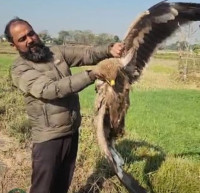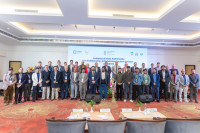National
Connectivity, infra projects top agenda of Oli’s China visit
Nepali delegation to pursue BRI implementation plan and trans-Himalayan connectivity projects in Beijing.
Anil Giri
Nepal is preparing to take up some key cross-border infrastructure and connectivity projects, including joint projects under the Belt and Road Initiative, during Prime Minister KP Sharma Oli’s official visit to China starting December 2.
At the invitation of Chinese Premier Li Qiang, Prime Minister Oli is visiting the northern neigbour. The two sides have started exchanging agendas and drafting a joint communiqué that will be issued at the end of the visit.
“We have received the draft of the joint communiqué and agenda of the visit from the Chinese side,” a senior foreign ministry official said. “But we have yet to finalise the agenda and forward our comments to the Chinese side on the joint communiqué.”
Among other proposals, the Chinese side has offered a $20 million grant as budgetary support to Nepal, even as the Ministry of Finance expressed dissatisfaction with the amount.
According to multiple officials from various ministries, Nepal is preparing a long list of projects to be developed under the framework of the Belt and Road Initiative (BRI) as well as other cross-border infrastructure and connectivity-related projects. This also includes implementing projects agreed during past high-level visits.
The Nepali list that is in the works places on top the agenda of signing the BRI implementation plan. Currently, a four-member taskforce of the Nepali Congress and the CPN-UML is revising the draft of the BRI implementation plan proposed by the Chinese side in early 2020.
The Ministry of Foreign Affairs and the Ministry of Finance are finalising the list of projects to be taken up during the visit. The foreign ministry has received a long list of projects from different line ministries as well as provincial governments. Officials said they are simultaneously working on the list of projects and instruments to be signed during the visit and the joint communiqué to be issued at the conclusion of the visit.
Addressing a rally organised by the UML in Kathmandu on Friday, Prime Minister Oli said his China visit will be ‘historic’.
“My China visit is going to be a successful one. I am not going there for a tour, but for the people and the country. A delegation, under my leadership, is heading for China on December 2. The success of the visit will be clear at its conclusion,” the prime minister said.
He also ruled out taking loans from China with the ruling coalition partner, the Congress, is also in favor of grants to fund BRI-related infrastructure projects. In addition to signing the BRI implementation plan, the Nepali side has prioritised the implementation of the trade and transit agreement signed between Nepal and China in 2016 in the wake of the Indian blockade.
Dubbed a watershed in Nepal-China ties, the protocol of trade and transit agreement was signed in 2019 where China allowed Nepal to use its seven land and sea ports for bilateral and third-country trade. Only two shipments have moved in the five years since the signing of the trade and transit protocol.
At the proposal of the Ministry of Physical Infrastructure and Transportation, Nepal is preparing a list of projects that includes upgrading the Syabrubesi-Rasuwagadhi Highway. Likewise, the foreign and finance ministries have received proposals seeking Chinese assistance for the operationalisation and reliable opening of the Lizi-Nechung port (Mustang) and the reopening of the Zhangmu-Khasa port (Tatopani) for passenger services.
Similarly, another proposal is about acknowledging the smooth and orderly operation of passenger and cargo services at Pulan port (Yari) in Humla and Jilong port (Rasuwa) and calling on China to help improve the facilities on the Nepali side of the Lizi-Nechung port at the earliest.
Nepal has recently opened up immigration offices in Korala, opposite of Lizi-Nechung port, which is now closed due to cold weather. China has agreed to build an integrated check post and other facilities on the Nepali side but an agreement in this regard has yet to be reached.
During his Nepal visit in 2019, Chinese President Xi Jinping committed to supporting cross-border infrastructure and connectivity projects aimed at transforming Nepal from a landlocked country to a land-linked one.
Officials familiar with the matter said that while no specific projects have been proposed under this scheme, Nepal will seek Chinese support for projects aligned with this vision. During his visit, Xi had announced a grant of approximately Rs60 billion but this money has yet to be received.
During the prime minister’s visit, specific projects could be discussed to make use of this grant, officials said.
In order to execute the BRI, which Nepal joined in 2017, Nepal is working on developing joint BRI projects, whose details have yet to be worked out.
To enhance the connectivity between the two countries, a memorandum of understanding has been proposed for the development of the Tokha-Chhahare Tunnel. Also, Nepal has requested China to help build the Jilong/Keyrung-Kathmandu Cross-Border Railway, whose feasibility study is underway with Chinese funding. The study is expected to be complete in two years, but officials from various ministers said they are not sure about the kind of support that Nepal should seek from China.
Likewise, Nepal is preparing to raise the issue of air transport cooperation, seeking flights from different Chinese cities to Nepali cities. Nepal will also officially ask for conversion of the loan taken for Pokhara airport into a soft loan, along with expansion of air rights arrangements. Nepal has already requested China to convert the Rs26 billion loan into a grant as the airport has failed to generate much revenue since its opening in January 2023.
Also on the agenda, which is in the works, is reviving the old agreement with the Electric Power Corporation, along with a proposal to sign an Agreement on Nepal-China Electric Power Cooperation Plan, which focuses on developing hydropower projects and a cross-border transmission line.
Other proposals include signing of the memorandum of understanding for the construction of the Jilong/Kerung-Rasuwagadhi-Chilime 220kV cross-border power transmission line, which was initially discussed in 2016 during Oli’s official visit to China.
The construction of the China-Nepal Friendship Industrial Park in Damak, Jhapa which is also Oli’s pet project, is also on the list of agreements to be signed during the visit. The project is being undertaken in Oli’s electoral constituency in Jhapa district.
An agreement related to boundary management and security cooperation agreed during Chinese President Xi’s visit to Nepal is under consideration as well.
The implementation agreement between the governments of China and Nepal on the Boundary Management System is also part of agreement, according to officials. A copy of the proposed agreement has already been submitted to the House of Representatives, they said.
As per the proposal from the Ministry of Home Affairs, there is a plan to sign a memorandum of understanding between the Ministry of Public Security of China and Nepal’s Ministry of Home Affairs on the establishment of a Boundary Contact System at three levels, reads another proposal.
The Chinese side—and especially security officials from Tibet—has for long been pushing for Nepal to accept the boundary contact system at federal, provincial and local levels.
Another proposal includes signing a memorandum of understanding on law enforcement cooperation between Nepal and China, with provisions for Chinese support in immigration and security on the Nepali side of the border. But the proposal does not mention particular immigration and border points.
Among these proposals, some will be taken to Beijing, while some new ones can be added after discussions in the Cabinet, said officials from different line ministries.
On the list of instruments to be signed during the visit, according to the officials, are an exchange of letters on the Tokha-Chhahare Tunnel Project between the China International Development Cooperation Agency (CIDCA) and Nepal’s Ministry of Finance; an agreement between Nepal’s Ministry of Industry, Commerce, and Supplies and the General Administration of Nepal-China Border Port Management Cooperation Committee; and a memorandum of understanding on Trade Promotion Cooperation between China’s Ministry of Commerce and Nepal’s Ministry of Industry, Commerce, and Supplies.
Likewise, other instruments include a protocol between China’s General Administration of Customs and Nepal’s Ministry of Agriculture and Livestock Development on inspection, quarantine, and sanitary conditions for thermally processed buffalo meat products to be exported to China; BRI Agreement and Border Access; implementation of BRI projects to improve access for Nepalis to border areas; and expediting the Trans-Himalayan Multidimensional Connectivity Network (THMCN).
As a major component of the BRI, the THMCN encompasses a range of connectivity projects, such as ports, roads, railways, aviation, tunnels, digital connectivity, and connections among diverse communities. The concept was initially agreed upon by then foreign minister Pradeep Gyawali and his Chinese counterpart, Wang Yi, in April 2018. The concept of a THMDCN, with a long-term perspective, was announced on April 19, 2018.
During the recent visit of Deputy Prime Minister and Minister for Finance Bishnu Poudel to China, the two countries had reaffirmed their commitment to advance projects under the network, a Beijing-led concept the two sides agreed on in April 2018.
Reaffirmation of the commitment to advancing the network and other economic projects under the leadership of both countries, spells out a point of the proposed agenda which is yet to be discussed and approved by the Cabinet.
Officials who are tasked with preparing the final list of projects said that among the plethora of proposals received from different ministries, a few had been chosen and enlisted for presentation during bilateral talks. They said some new and some old projects are being taken up with the Chinese side.
The funding modality of these projects are yet to be discussed, they said, adding that the final list would be handed over to the Chinese. Of the projects in this final list, some will be prepared for signature and some put in the joint statement.




 8.12°C Kathmandu
8.12°C Kathmandu















